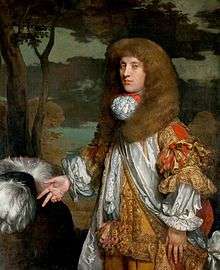John Hay, 2nd Marquess of Tweeddale
| The Marquess of Tweeddale | |
|---|---|
 Portrait by Gerard Soest. | |
| Lord Chancellor of Scotland | |
|
In office 1704–1705 | |
| Monarch | Queen Anne |
| Preceded by | The Earl of Seafield |
| Succeeded by | The Earl of Seafield |
| Lord High Commissioner to the Parliament of Scotland | |
|
In office 1704–1704 | |
| Monarch | Queen Anne |
| Preceded by | The Duke of Queensberry |
| Succeeded by | The Duke of Argyll |
| Personal details | |
| Born | 1645 |
| Died | 20 April 1713 (aged 68) |
| Political party | Squadrone Volante |
| Spouse(s) | Lady Mary Maitland |
| Children | Charles, John |
| Military service | |
| Allegiance |
|
| Years of service | 1668-1689 |
| Rank | Colonel |
John Hay, 2nd Marquess of Tweeddale (1645 – 20 April 1713) was a Scottish nobleman.
Hay was the eldest son of John Hay, 1st Marquess of Tweeddale and his wife, Jean, daughter of Walter Scott, 1st Earl of Buccleuch. In 1666, at Highgate in London, he married Lady Mary Maitland, daughter of John Maitland, 1st Duke of Lauderdale (1616–82). However, Lauderdale set himself against Hay, who was forced to leave for the continent and did not regain his position until Lauderdale's death in 1682.
He was Colonel of the Militia Regiment of Foot in Co Haddington (1668–1674) and Linlithgow and Peebles (1682). He was Burgess of Edinburgh (1668), Commissioner for the Borders (1672–1684), Commissioner of Supply for Haddington (1678, 1685, 1690, 1704), Peebles (1678, 1685), Edinburgh (1690, 1704), Fife (1695, 1704), Berwick (1704); Colonel of the East Lothian Regiment (1685), Captain of the Militia Horse for Haddington and Berwick (1689), Privy Councillor (Scotland) (1689), Sheriff of Haddington (1694–1713) and Commissioner of the Admiralty (Scotland) (1695).[1]
He was also Lord Treasurer in 1695. He succeeded his father in the marquessate in 1697.
He was appointed Lord High Commissioner to the Scots Parliament in 1704, and was Lord Chancellor of Scotland from 1704–05. He led the Squadrone Volante, but ultimately supported the Union. He was appointed one of 18 Scottish representative peers in 1707.
His eldest son, Charles (c. 1670–1715), succeeded him as 3rd Marquess. A younger son, Lord John Hay (d. 1706), commanded the famous regiment of dragoons, afterwards called the Scots Greys, at the Battle of Ramillies and elsewhere.
He had been elected a Fellow of the Royal Society in 1666 but was expelled in 1685.[2]
References
 Stephen, Leslie; Lee, Sidney, eds. (1891). "Hay, John (1645-1713)". Dictionary of National Biography. 25. London: Smith, Elder & Co.
Stephen, Leslie; Lee, Sidney, eds. (1891). "Hay, John (1645-1713)". Dictionary of National Biography. 25. London: Smith, Elder & Co.
- ↑ "Library and Archive Catalogue". Royal Society. Retrieved 12 November 2010.
- ↑ "Library and Archive Catalogue". Royal Society. Retrieved 12 November 2010.
| Political offices | ||
|---|---|---|
| Preceded by ? |
Treasurer of Scotland 1695–? |
Succeeded by Unknown |
| Preceded by The Duke of Queensberry |
Lord High Commissioner to the Scottish Parliament 1704 |
Succeeded by The Duke of Argyll |
| Preceded by The Earl of Seafield |
Lord Chancellor of Scotland 1704–1705 |
Succeeded by The Earl of Seafield |
| Peerage of Scotland | ||
| Preceded by John Hay, 1st Marquess of Tweeddale |
Marquess of Tweeddale 1697–1713 |
Succeeded by Charles Hay, 3rd Marquess of Tweeddale |